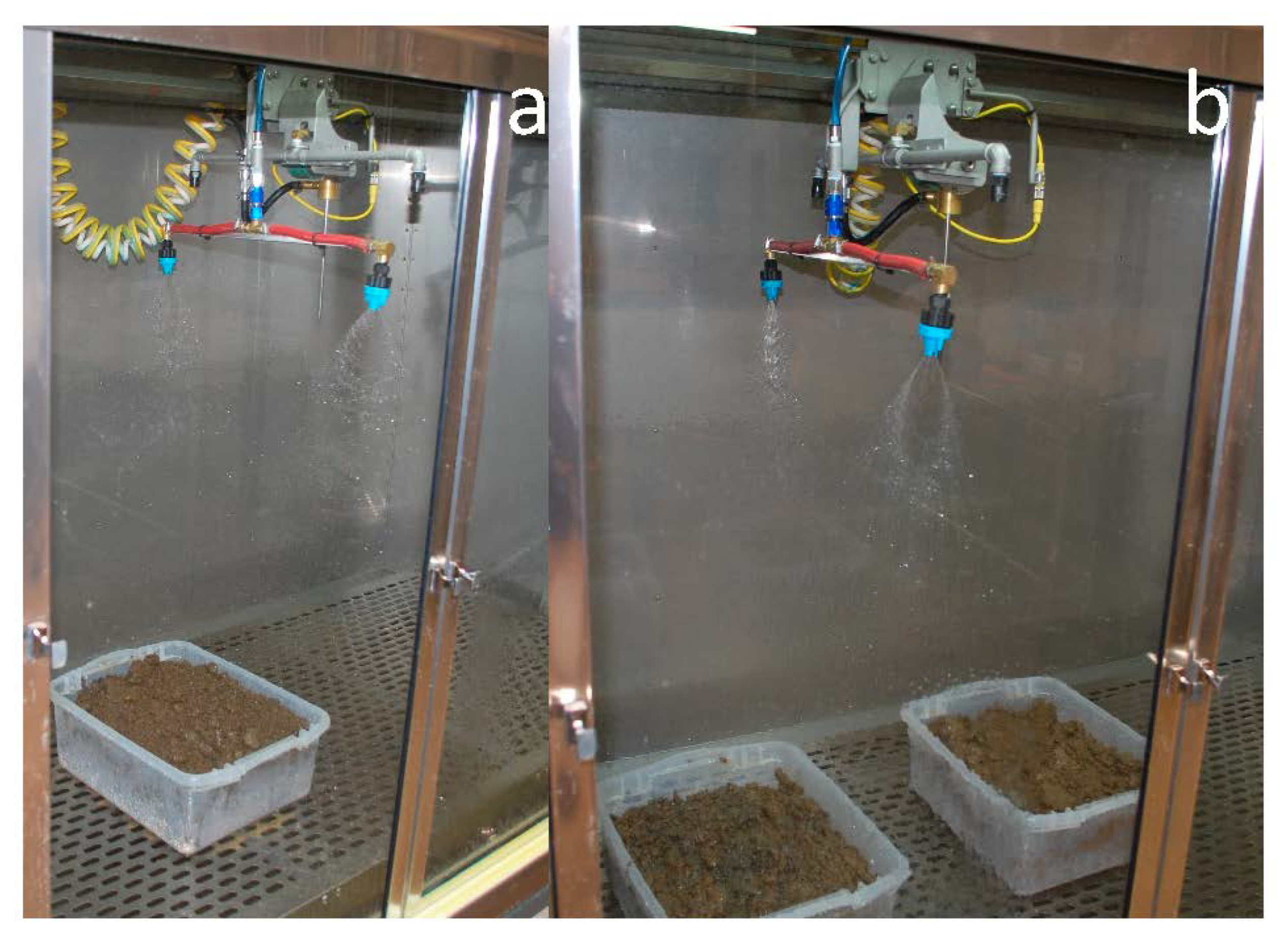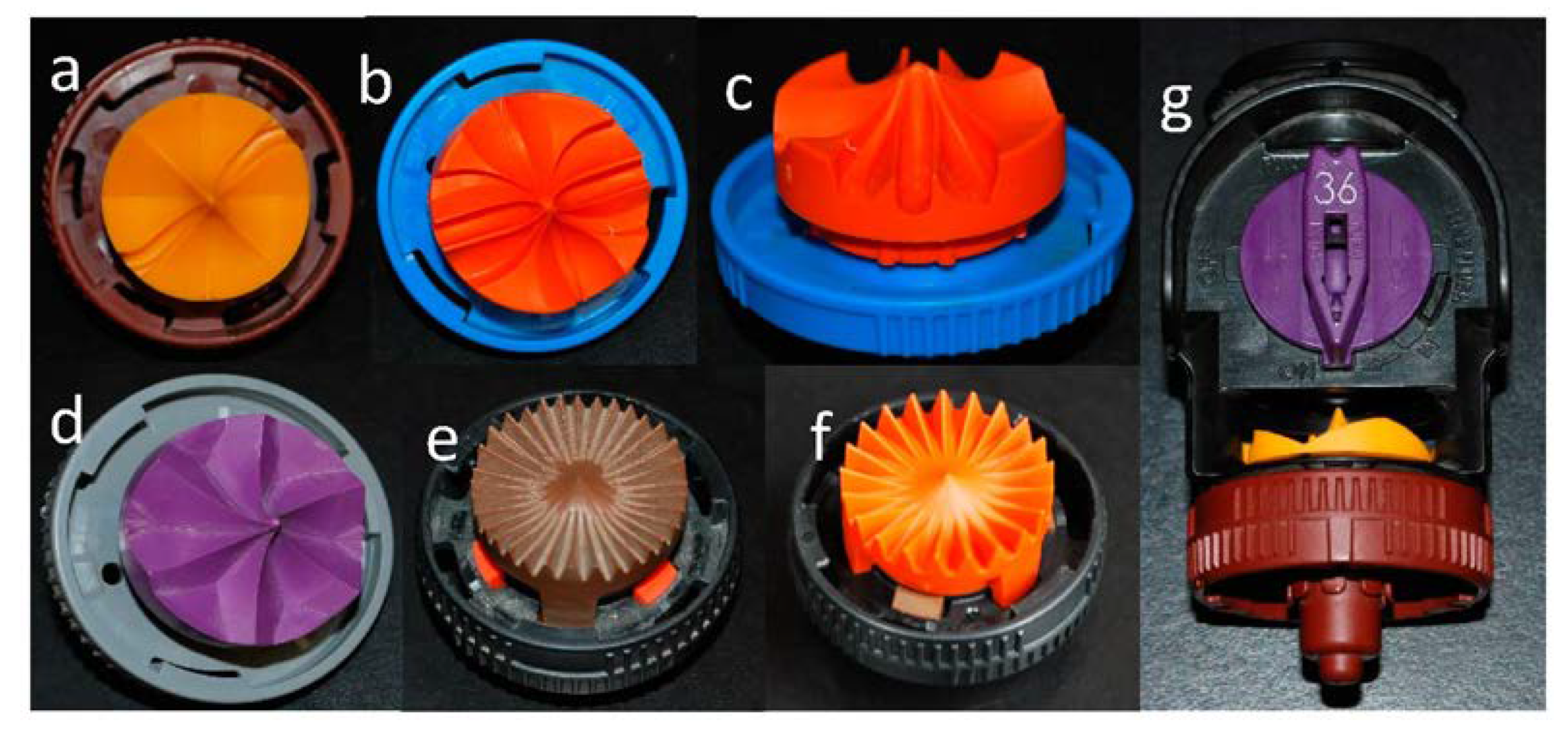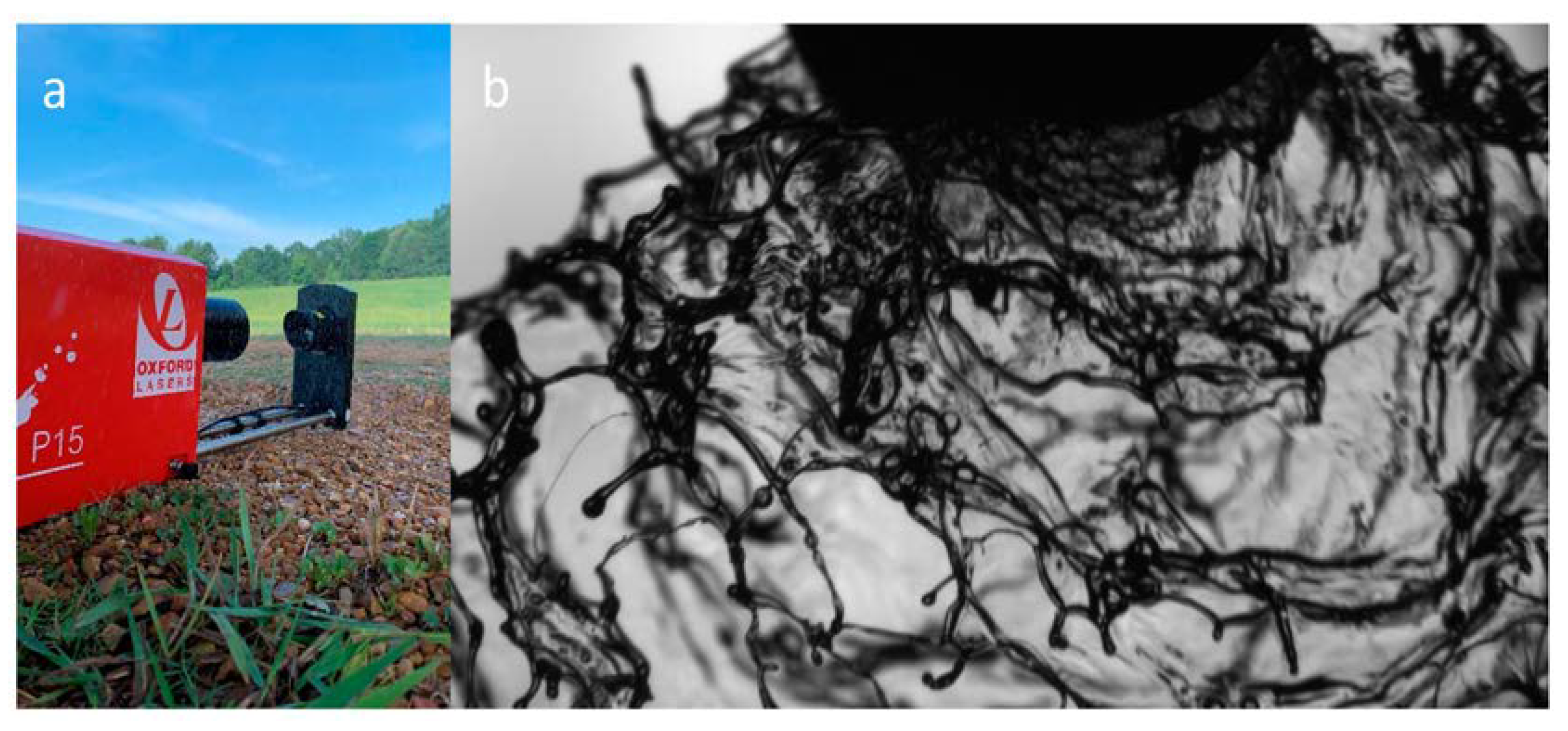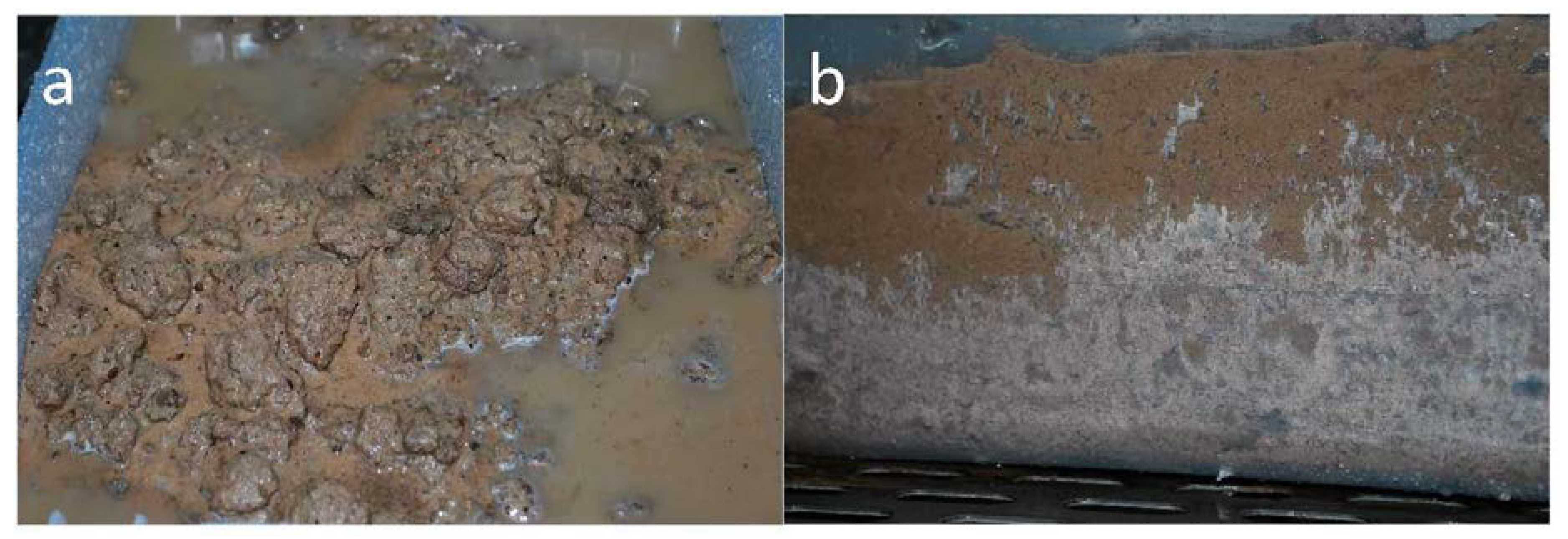Optimizing Overhead Irrigation Droplet Size for Six Mississippi Soils
Abstract
:1. Introduction
2. Materials and Methods
2.1. Soil Type Selection
2.2. Overhead Irrigation Duration Study
2.3. Overhead Irrigation Intensity Study
2.4. Irrigation Nozzle Droplet Measurement Study
2.5. Statistical Analyses
3. Results and Discussion
3.1. Overhead Irrigation Duration Study Results
3.2. Overhead Irrigation Intensity Study Results
3.3. Irrigation Sprinkler Droplet Sizing Results
4. Conclusions
Author Contributions
Funding
Conflicts of Interest
References
- NASS. Census of Agriculture–Mississippi State and County Data; Publication number AC-17-A-24; National Agricultural Statistics Service (NASS): Washington, DC, USA, 2019.
- NASS. Census of Agriculture–2018 Irrigation and Water Management Survey; Publication number AC-17-SS-1; National Agricultural Statistics Service (NASS): Washington, DC, USA, 2019.
- Ellis, J.E.; Kruse, E.G.; McSay, A.E.; Neale, C.M.U.; Horn, R.A. A comparison of five irrigation methodson onions. Hortic. Sci. 1986, 21, 1349–1351. [Google Scholar]
- Al-Jamal, M.S.; Ball, S.; Sammis, T.W. Comparison of sprinkler, trickle and furrow irrigation efficiencies for onion production. Agric. Water Manag. 2001, 46, 253–266. [Google Scholar] [CrossRef]
- Kebede, H.; Fisher, D.K.; Sui, R.; Reddy, K.N. Irrigation methods and scheduling in the delta region of Mississippi: Current status and strategies to improve irrigation efficiency. Am. J. Plant Sci. 2014, 5, 2917–2928. [Google Scholar] [CrossRef] [Green Version]
- Burt, C.M.; Clemmens, A.J.; Strelkoff, T.S.; Solomon, K.H.; Bliesner, R.D.; Hardy, L.A.; Howell, T.A.; Eisenhauer, D.E. Irrigation performance measures: Efficiency and uniformity. J. Irrig. Drain. Eng. 1997, 123, 423–442. [Google Scholar] [CrossRef] [Green Version]
- Krutz, J. Delta Aquifer Declining at Alarming Rate. Farm Progress. Available online: https://www.farmprogress.com/land-management/delta-aquifer-declining-alarming-rate (accessed on 31 January 2014).
- Clark, B.R.; Hart, R.M.; Gurdak, J.J. Groundwater Availability of the Mississippi Embayment; Professional Paper 1785; U.S. Geological Survey: Reston, VA, USA, 2011; 62p.
- El-Hendawy, S.E.; Schmidhalter, U. Optimal coupling combinations between irrigation frequency and rate for drip-irrigated maize grown on sandy soil. Agric. Water Manag. 2010, 97, 439–448. [Google Scholar] [CrossRef]
- Irmak, S.; Djaman, K.; Rudnick, D.R. Effect of full and limited irrigation amount and frequency on subsurface drip-irrigated maize evapotranspiration, yield, water use efficiency and yield response factors. Irrig. Sci. 2016, 34, 271–286. [Google Scholar] [CrossRef]
- De Graff, J. The Price of Soil Erosion: An Economic Evaluation of Soil Conservation and Watershed Development; Mansholt Studies; Backhuys Publishers: Leiden, The Netherlands, 1996; p. 299. [Google Scholar]
- Thompson, A.L.; James, L.G. Water droplet impact and its effect on infiltration. Trans. ASAE 1985, 28, 1506–1520. [Google Scholar] [CrossRef]
- Spillman, J.J. Spray impactions, retention and adhesions: An introduction to basic characteristics. Pestic. Sci. 1984, 15, 97–106. [Google Scholar] [CrossRef]
- Dorr, G.J.; Kempthorne, D.M.; Mayo, L.C.; Forster, W.A.; Zabkiewicz, J.A.; McCue, S.W.; Belward, J.A.; Turner, I.W.; Hanan, J. Towards a model of spray-canopy interactions: Interception, shatter, bounce and retention of droplets on horizontal leaves. Ecol. Model. 2014, 290, 94–101. [Google Scholar] [CrossRef] [Green Version]
- Dorr, G.J.; Wang, S.; Mayo, L.C.; McCue, S.W.; Forster, W.A.; Hanan, J.; He, X. Impaction of spray droplets on leaves: Influence of formulation and leaf character on shatter, bounce and adhesion. Exp. Fluids 2015, 56, 1–17. [Google Scholar] [CrossRef] [Green Version]
- Forster, W.A.; Gaskin, R.E.; Strand, T.M.; Manktelow, D.W.L.; van Leeuwen, R.M. Effect of target wettability on spray droplet adhesion, retention, spreading and coverage: Artificial collectors versus plant surfaces. N. Z. Plant Prot. 2014, 67, 284–291. [Google Scholar] [CrossRef] [Green Version]
- Spurgeon, W.E.; Thompson, T.L.; Gilley, J.R. Irrigation Management Using Hourly Spray Evaporation Loss Estimates; ASAE Paper No. 83-2591; ASAE: St. Joseph, MI, USA, 1983. [Google Scholar]
- McLean, R.K.; Sri Ranjan, R.; Klassen, G. Spray evaporation losses from sprinkler irrigation systems. Can. Agric. Eng. 2000, 42, 1–15. [Google Scholar]
- Li, S.; Li, H.; Xu, C.Y.; Huang, X.R.; Xie, D.T.; Ni, J.P. Particle interaction forces induce soil particle transport during rainfall. Soil Soc. Am. J. 2013, 77, 1563–1571. [Google Scholar] [CrossRef]
- Nearing, M.A.; Bradford, J.M.; Holtz, R.D. Measurement of waterdrop impact pressures on soil surfaces. Soil Sci. Am. J. 1987, 51, 1302–1306. [Google Scholar] [CrossRef]
- Ghadiri, H. Crater formation in soils by raindrop impact. Earth Surf. Process. Landf. 2004, 29, 77–89. [Google Scholar] [CrossRef] [Green Version]
- Ekern, P.C. Raindrop impact as the force initiating soil erosion. Soil Sci. Soc. Am. J. 1951, 15, 7–10. [Google Scholar] [CrossRef] [Green Version]
- Kinnell, P.I.A. The mechanics of raindrop induced flow transport. Aust. J. Soil Res. 1990, 28, 497–516. [Google Scholar] [CrossRef]
- Shainberg, I.; Levy, G.J.; Rengasamy, P.; Frenkel, H. Aggregate stability and seal formation as affected by drops’ impact energy and soil amendments. Soil Sci. 1992, 154, 113–119. [Google Scholar] [CrossRef]
- Van Dijk, A.I.J.M.; Bruijnzeel, L.A.; Rosewell, C.J. Rainfall intensity-kinetic energy relationships: A critical literature appraisal. J. Hydrol. 2002, 261, 1–23. [Google Scholar] [CrossRef]
- Legout, C.; Leguedois, S.; Le Bissonnais, Y. Aggregate breakdown dynamics under rainfall compared with aggregate stability measurements. Eur. J. Soil Sci. 2005, 56, 225–238. [Google Scholar] [CrossRef]
- Wang, L.; Shi, Z.H.; Wang, J.; Fang, N.F.; Wu, G.L.; Zhang, H.Y. Rainfall kinetic energy controlling erosion processes and sediment sorting on steep hillslopes: A case study of clay loam soil from the loess plateau, China. J. Hydrol. 2014, 512, 168–176. [Google Scholar] [CrossRef]
- Hu, F.; Liu, J.; Xu, C.; Wang, Z.; Liu, G.; Li, H.; Zhao, S. Soil internal forces initiate aggregate breakdown and splash erosion. Geoderma 2018, 320, 43–51. [Google Scholar] [CrossRef]
- Legout, C.; Leguedois, S.; Le Bissonnais, Y.; Malam Issa, O. Splash distance and size distributions for various soils. Geoderma 2005, 124, 279–292. [Google Scholar] [CrossRef]
- Ramos, M.C.; Nacci, S.; Pla, I. Effect of raindrop impact and its relationship with aggregate stability to different disaggregation forces. Catena 2003, 53, 365–376. [Google Scholar] [CrossRef]
- Falsone, G.; Bonifacio, E.; Zanini, E. Structure development in aggregates of poorly developed soils through the analysis of the pore system. Catena 2012, 95, 169–176. [Google Scholar] [CrossRef]
- Vaezi, A.R.; Ahmadi, M.; Cerdà, A. Contribution of raindrop impact to the change of soil physical properties and water erosion under semi-arid rainfalls. Sci. Total Environ. 2017, 583, 382–392. [Google Scholar] [CrossRef]
- Sachs, E.; Sarah, P. Effect of raindrop temperatures on soil runoff and erosion in dry and wet soils: A laboratory experiment. Land Degrad. Dev. 2017, 28, 1549–1556. [Google Scholar] [CrossRef]
- Shi, Z.H.; Yan, F.L.; Li, L.; Li, Z.X.; Cai, C.F. Interrill erosion from disturbed and undisturbed samples in relation to topsoil aggregate stability in red soils from subtropical China. Catena 2010, 81, 240–248. [Google Scholar] [CrossRef]
- Rose, C.W.; Williams, J.R.; Sander, G.C.; Barry, D.A. A mathematical model of soil erosion and deposition processes: I. Theory for a plane land element. Soil Sci. Soc. Am. J. 1983, 47, 991–995. [Google Scholar] [CrossRef]
- Warrington, D.N.; Mamedov, A.I.; Bhardwaj, A.K.; Levy, G.J. Primary particle size distribution of eroded material affected by degree of aggregate slaking and seal development. Eur. J. Soil Sci. 2009, 60, 84–93. [Google Scholar] [CrossRef]
- Hewitt, A.J. The importance of droplet size in agricultural spraying. At. Sprays 1997, 7, 235–244. [Google Scholar] [CrossRef]
- Ferguson, J.C.; O’Donnell, C.C.; Chauhan, B.S.; Adkins, S.W.; Kruger, G.R.; Wang, R.; Urach Ferreira, P.H.; Hewitt, A.J. Determining the uniformity and consistency of droplet size across spay drift reducing nozzles in a wind tunnel. Crop Prot. 2015, 76, 1–6. [Google Scholar] [CrossRef]
- Tishkoff, J.M. Spray characterization: Practices and requirements. Opt. Eng. 1984, 23, 557–560. [Google Scholar] [CrossRef]
- Ma, Z.; Merkus, H.G.; de Smet, J.G.A.E.; Heffels, C.; Scarlett, B. New developments in particle characterization by laser diffraction: Size and shape. Powder Technol. 2000, 111, 66–78. [Google Scholar] [CrossRef]
- Bachalo, W.D.; Houser, M.J. Spray drop size and velocity measurements using the phase/doppler particle analyzer. Int. J. Turbo Jet Engines 1987, 4, 207–215. [Google Scholar] [CrossRef]
- Ferguson, J.C.; Calhoun, J.S.; Broster, K.L.; Merritt, L.H.; Wesley, M.T., Jr.; Treadway, Z.R.; Fleitz, N. Effect of nozzle selection on weed control and yield in Mississippi cotton. In Proceedings of the Beltwide Cotton Conferences, New Orleans, LA, USA, 8–10 January 2019. [Google Scholar]
- Dadiao, C.; Wallender, W.W. Droplet size distribution and water application with low-pressure sprinklers. Trans. ASAE 1985, 28, 511–516. [Google Scholar] [CrossRef]
- Hills, D.J.; Gu, Y. Sprinkler volume mean droplet diameter as a function of pressure. Trans. ASAE 1989, 32, 471–476. [Google Scholar] [CrossRef]
- Li, J.; Kawano, H.; Yu, K. Droplet size distributions from different shaped sprinkler nozzles. Trans. ASAE 1994, 37, 1871–1878. [Google Scholar] [CrossRef]
- Li, J. Effect of pressure and nozzle shape on the characteristics of sprinkler droplet spectra. J. Agric. Eng. Res. 1997, 66, 15–21. [Google Scholar] [CrossRef]
- Montero, J.; Tarjuelo, J.M.; Carrion, P. Sprinkler droplet size distribution measured with an optical spectropluviometer. Irrig. Sci. 2003, 22, 47–56. [Google Scholar] [CrossRef]
- Soil Survey Staff. Official Soil Series Descriptions: National Resources Conservation Service. Available online: https://soilseries.sc.egov.usda.gov/osdname.aspx (accessed on 16 March 2020).
- DeBolt, D.C. A high sample volume procedure for the colorimetric determination of soil organic matter. Commun. Soil Sci. Plant Anal. 1974, 5, 131–137. [Google Scholar] [CrossRef]
- Lancaster, J.D. Soil Test Calibration and Fertilizer Recommendations; Mississippi Agricultural and Forestry Experiment Station Mimeograph; Mississippi State University: Mississippi State, MS, USA, 1970. [Google Scholar]
- Rasberry, F.P.; Lancaster, J.D. A comparative evaluation of the Mississippi soil test method for determining available manganese, magnesium, and calcium. Commun. Soil Sci. Plant Anal. 1977, 8, 327–339. [Google Scholar] [CrossRef]
- Mehlich, A. Uniformity of expressing sol test results. A case for calculating results on a volume basis. Commun. Soil Sci. Plant Anal. 1972, 3, 417–424. [Google Scholar] [CrossRef]
- Le Bissonnais, Y. Aggregate stability and assessment of soil crustability and erodibility: I. Theory and methodology. Eur. J. Soil Sci. 1996, 47, 425–437. [Google Scholar] [CrossRef]
- Nciizah, A.D.; Wakindiki, I.C. Soil sealing and crusting effects on infiltration rate: A critical review of shortfalls in prediction models and solutions. Arch. Agron. Soil Sci. 2015, 61, 1211–1230. [Google Scholar] [CrossRef]
- ASABE/ANSI. Spray Nozzle Classification by Droplet Spectra; Stand. 572.2; American Society of Agricultural and Biological Engineers: St. Joseph, MI, USA, 2018. [Google Scholar]




| Soil Type | USDA Soil Texture | Organic Matter | pH | P | K | Ca | Mg | Zn |
|---|---|---|---|---|---|---|---|---|
| % | kg ha−1 | |||||||
| Delta Soils | ||||||||
| Commerce Silt Loam | Medium | 1.7 | 6.0 | 190 | 523 | 4353 | 883 | 3.93 |
| Dubbs Silt Loam | Medium | 2.6 | 7.0 | 248 | 840 | 8299 | 1915 | 5.28 |
| Sharkey Clay | Fine | 2.1 | 7.4 | 122 | 664 | 12,433 | 3752 | 2.47 |
| Hills Soils | ||||||||
| Brooksville Silty Clay | Fine | 2.6 | 5.1 | 86 | 347 | 9424 | 172 | 1.12 |
| Leeper Silty Clay Loam | Moderately Fine | 1.8 | 6.2 | 203 | 497 | 3563 | 177 | 1.12 |
| Marietta Fine Sandy Loam | Moderately Coarse | 1.5 | 5.4 | 131 | 120 | 1545 | 72 | 1.68 |
| Soil Type | Optimal Irrigation Duration | Optimal Irrigation Intensity |
|---|---|---|
| mm | seconds | |
| Delta Soils | ||
| Commerce Silt Loam | 15.88 d | 153 |
| Dubbs Silt Loam | 22.23 a | 138 |
| Sharkey Clay | 21.43 ab | 134 |
| Hills Soils | ||
| Brooksville Silty Clay | 19.85 bc | 140 |
| Leeper Silty Clay Loam | 19.05 c | 138 |
| Marietta Fine Sandy Loam | 18.26 c | 156 |
| Sprinkler | Dv0.1 | Dv0.5 | Dv0.9 | Maximum Droplet Size | RS 2 | Sphericity |
|---|---|---|---|---|---|---|
| µm | % | |||||
| Accelerator | 237 | 757 | 1152 | 1156 | 1.22 | 90.7 |
| Rotator S1 1 | 214 | 506 | 1072 | 1084 | 1.51 | 90.7 |
| Rotator S2 | 243 | 904 | 1467 | 1514 | 1.43 | 89.0 |
| Rotator S3 | 186 | 482 | 847 | 867 | 1.39 | 89.3 |
| Spinner | 324 | 897 | 1117 | 1117 | 0.88 | 91.7 |
| Sprayhead Brown | 159 | 346 | 726 | 741 | 1.64 | 90.0 |
| Sprayhead Orange | 179 | 327 | 601 | 638 | 1.26 | 91.3 |
© 2020 by the authors. Licensee MDPI, Basel, Switzerland. This article is an open access article distributed under the terms and conditions of the Creative Commons Attribution (CC BY) license (http://creativecommons.org/licenses/by/4.0/).
Share and Cite
Ferguson, J.C.; Krutz, L.J.; Calhoun, J.S.; Gholson, D.M.; Merritt, L.H.; Wesley, M.T., Jr.; Broster, K.L.; Treadway, Z.R. Optimizing Overhead Irrigation Droplet Size for Six Mississippi Soils. Agronomy 2020, 10, 574. https://doi.org/10.3390/agronomy10040574
Ferguson JC, Krutz LJ, Calhoun JS, Gholson DM, Merritt LH, Wesley MT Jr., Broster KL, Treadway ZR. Optimizing Overhead Irrigation Droplet Size for Six Mississippi Soils. Agronomy. 2020; 10(4):574. https://doi.org/10.3390/agronomy10040574
Chicago/Turabian StyleFerguson, J. Connor, L. Jason Krutz, Justin S. Calhoun, Drew M. Gholson, Luke H. Merritt, Michael T. Wesley, Jr., Kayla L. Broster, and Zachary R. Treadway. 2020. "Optimizing Overhead Irrigation Droplet Size for Six Mississippi Soils" Agronomy 10, no. 4: 574. https://doi.org/10.3390/agronomy10040574
APA StyleFerguson, J. C., Krutz, L. J., Calhoun, J. S., Gholson, D. M., Merritt, L. H., Wesley, M. T., Jr., Broster, K. L., & Treadway, Z. R. (2020). Optimizing Overhead Irrigation Droplet Size for Six Mississippi Soils. Agronomy, 10(4), 574. https://doi.org/10.3390/agronomy10040574






